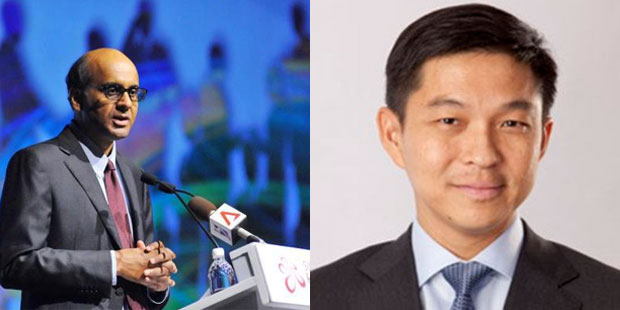They first appeared together in parliament two weeks ago to speak about the Central Provident Fund (CPF).
Deputy Prime Minister and Finance Minister Tharman Shanmugaratnam explained how CPF monies were invested and backed by the government, while Manpower Minister Tan Chuan-Jin clarified misconceptions about the CPF Minimum Sum.
Source: Lee Hsien Loong Facebook page
The two Ministers reappeared to talk about CPF again, this time as guest speakers at today's forum on CPF and Retirement Adequacy, organised by think tank Institute of Policy Study (IPS).
The forum was attended by academics, economists, fund experts as well as representatives of social and public organisations. Roy Ngerng, the CPF blogger who is being sued by Prime Minister Lee Hsien Loong for defamation, was among the participants.
Minister Tan explained how CPF works
Today, Minister Tan was the opening act, leading a pre-lunch dialogue session on CPF. Below are four key points of his speech:
1. On longevity: The most important factor that shapes any pension system is longevity. Life expectancy in Singapore is increasing. When CPF was introduced in 1955, life expectancy was about 60 to 62 years ago. For those turning 65 today, one in two will live beyond 85. One in three will live beyond 90.
2. On Savings: Many of the countries in the world have a savings system, where a basic level of savings is enforced. The question lies whether Singaporeans save enough to have a nest-egg that can last us a long time.
3. On Sustainability: It is important to keep the CPF system sustainable, so that our children’s generation will not be unduly burdened.
Source: Ministry of Manpower
4. How the CPF works: Accumulation phase vs Decumulation phase
For instance, the retirement age will have a bearing on how much more we can accumulate and how much we can draw out on a more sustainable basis.
DPM Tharman on studying how CPF members can earn higher returns
Next up was DPM Tharman, who spoke at the closing dialogue session. Here are the key takeaways of his speech:
1. Changes to CPF significant over the years:
1st Phase (people were poor and home ownership limited) - CPF worked like a simple savings scheme for home ownership. Many Singaporeans in the older generation are asset rich and cash poor.
2nd Phase (mid 1990s) - Special, Medisave and Retirement Accounts were put in place. Limited were introduced for CPF withdrawal for housing; and Minimum Sum Scheme was implemented.
CPF today - There are enhanced government subsidies for CPF members, targeted at lower and middle income CPF members (regular top-ups through Workfare).
2. Improvements will be made CPF while keeping its basic strengths:
i) Fair return to CPF members wihout exposing them to financial risks they cannot carry.
ii) Keeping CPF sustainable for the long term.
3. The government is studying how to provide better options for CPF members:
These options could be provided for members who are able to take higher risks, so that they can earn higher returns compared to the CPF Investment scheme system.
One option is to allow members to use CPF monies to invest in private pension plans. But such options have to be studied carefully and that people have to understand the risks involved.
If you like what you read, follow us on Facebook, Instagram, Twitter and Telegram to get the latest updates.

